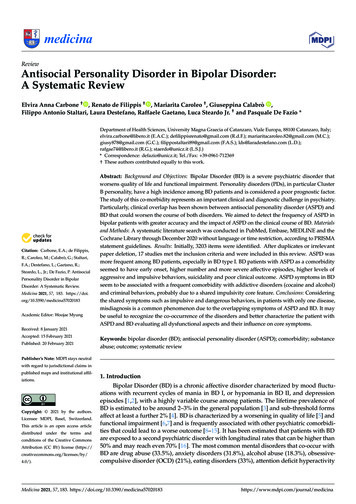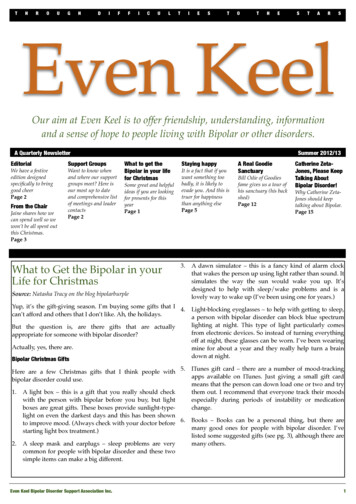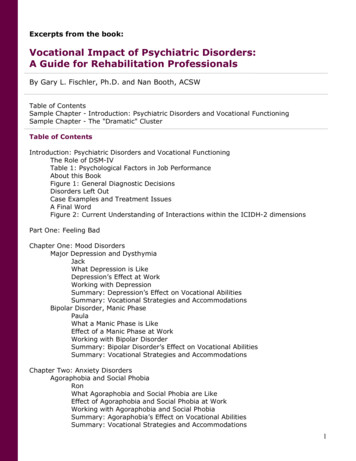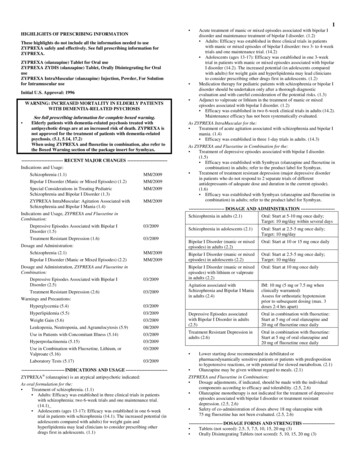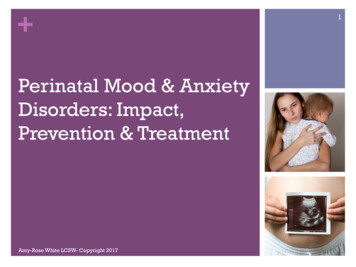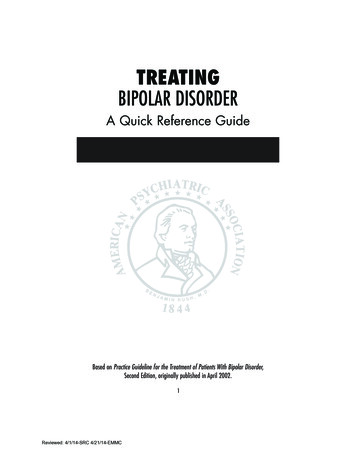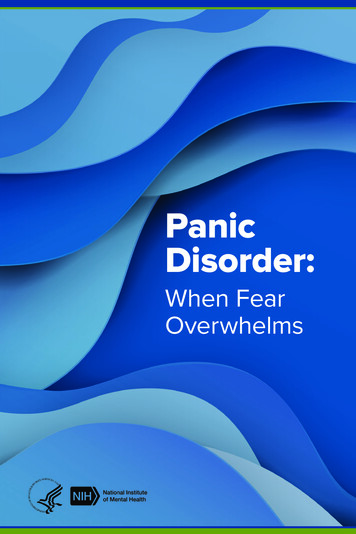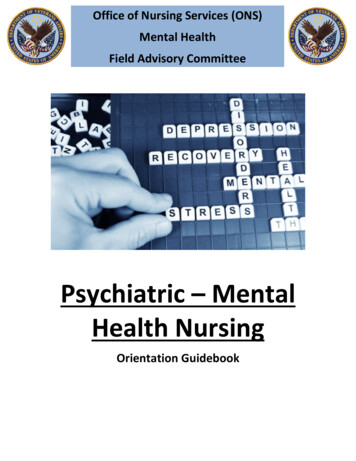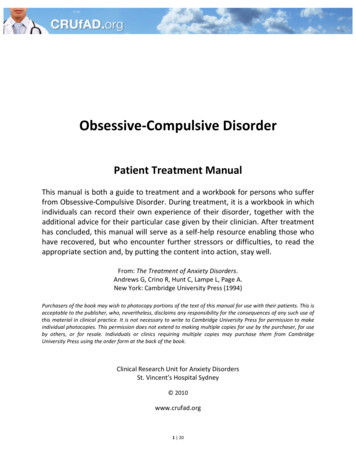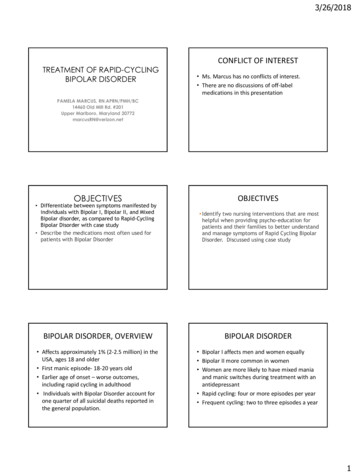
Transcription
3/26/2018TREATMENT OF RAPID-CYCLINGBIPOLAR DISORDERCONFLICT OF INTEREST Ms. Marcus has no conflicts of interest. There are no discussions of off-labelmedications in this presentationPAMELA MARCUS, RN,APRN/PMH/BC14460 Old Mill Rd. #201Upper Marlboro, Maryland 20772marcusRN@verizon.netOBJECTIVES Differentiate between symptoms manifested byindividuals with Bipolar I, Bipolar II, and MixedBipolar disorder, as compared to Rapid-CyclingBipolar Disorder with case study Describe the medications most often used forpatients with Bipolar DisorderOBJECTIVES Identify two nursing interventions that are mosthelpful when providing psycho-education forpatients and their families to better understandand manage symptoms of Rapid Cycling BipolarDisorder. Discussed using case studyBIPOLAR DISORDER, OVERVIEWBIPOLAR DISORDER Affects approximately 1% (2-2.5 million) in theUSA, ages 18 and older First manic episode- 18-20 years old Earlier age of onset – worse outcomes,including rapid cycling in adulthood Individuals with Bipolar Disorder account forone quarter of all suicidal deaths reported inthe general population. Bipolar I affects men and women equally Bipolar II more common in women Women are more likely to have mixed maniaand manic switches during treatment with anantidepressant Rapid cycling: four or more episodes per year Frequent cycling: two to three episodes a year1
3/26/2018BIPOLAR IBIPOLAR I One or more manic episode alternating with amajor depressive episode Manic episode – Persistent elevated,expansive or irritable mood Sleep disturbances Increase distracted, restless Impulsive behavior Exaggerated self-esteem Manic episodes begin suddenly – lasting a fewdays to a few months Abrupt mood shifts – rapid changes fromeuphoria to anger or depression Individuals with depressive symptoms tend tobe less responsive to conventional therapyBIPOLAR IIRAPID CYCLING Major depressive episode and one hypomanicepisode No history of a manic or mixed episode No psychotic features Hypomanic episodes usually occur before orafter a major depressive episode Diagnosis is difficult Four or more manic episodes for at least 2weeks in a year Have partial or full remission for 2 months orswitch to the opposite mood (if manic;switches to depressed mood) High risk of recurrence and resistance totreatment Greater severity of symptoms of mania anddepressionETIOLOGY:GENETICTheories of Etiology Bipolar disorders – highly inheritable Complex mode of inheritance, involvingmultiple interacting genes Dysregulation in gene G protein receptorkinase 3 (GRK3) – dopamine metabolism Polygenic2
3/26/2018NEUROANATOMIC ISSUES Genetic: Concordance rates in monozygotic twins67% ; Dizygotic twins 19%. Research is being done on genetic testing for bipolardisorder; including where the genetic disruption maybe occurring Genetic association of serotonin system genes isbeing conducted Volume reduction in subregion of prefrontalcortex Amygdala and striatal enlargement Midline cerebellar atrophy Enlarged lateral and third ventricle with whitematter hyperdensity in 10-30% of individualswith bipolar disorderNEUROTRANSMITTERSPSYCHOLOGICAL INFLUENCESETIOLOGY:GENETIC Increase in sensitivity of postsynaptic receptors Dysregulation in dopamine and serotonin alongwith deficits in other systems, such as GABA Signaling pathway abnormalities and alteredneurotransmitters; G proteins translate thesignals and relay the signals to the secondmessenger systems are increased with bipolardisorder Response to biological makeup and copingskills Faulty beliefs about self and the world aroundthem Risks do not have consequences Goal striving – euphoria – drive increasesregardless of feedback from others anddisruption in daily routinePSYCHOLOGICAL INFLUENCES Psychosocial stressors trigger bipolar episodesby disruption of usual social rhythms Disruption of circadian systemsMEDICATION MANAGEMENT3
3/26/2018CHOOSE THE BEST MEDICATION Syndrome targeting (the pattern and stage ofthe illness) Symptom targeting Awareness of interactions Best drug class Mechanisms of drug actionCHOOSE THE BEST MEDICATION Symptoms presented History and patterns of illness Side effect profile Personal and family responses to treatment Cost Ease of administration Onset of action Drug to drug interactionUSE OF LITHIUM LiCo3 is an older mood stabilizer,continues to demonstrate goodtherapeutic results and is seen as thefirst line treatment for a mood stabilizerMOOD STABILIZER Treatment of choice in manic phase LiCo3 and Valproate are the two first line treatmentchoices Second line alternative is Carbamazepne or LiCo3and valproateMOOD STABILIZERS Rapid cycling: Valproate; first line Carbamazepine; first line Second line alternative:–LiCo3 and valproate–LiCo3–LiCo3 and carbamazepine4
3/26/2018MOOD STABILIZERS Mixed episode or dysphoric mood: Valproate; first line LiCo3 or Carbamazepine Gabapentin Lamotrigine Topiramate Second line alternative: LiCo3 and valproateADJUNTIVE MEDICATIONSADJUNTIVE MEDICATIONS Manic with psychosis:Therapeutic goal:Control psychosisInduce sleep and sedationADJUNCTIVE MEDICATIONS First line: and a high or medium potencyantipsychotic to the mood stabilizer Benzodiazepine may be added to theantipsychotic and mood stabilizer Low potency antipsychotic Severe mania without psychosis Add a benzodiazepine to the mood stabilizer Add a high or medium potency antipsychoticto the mood stabilizer and benzodiazepine.ADJUNTIVE MEDICATIONSTREATING THE ACUTE PHASE Hypomanic: Add a benzodiazepine to the mood stabilizer Add a high or medium potency antipsychotic– This is rarely needed, but is sometimeshelpful. Major depression with psychotic features: ECT Mood stabilizer and antidepressant with anantipsychotic5
3/26/2018TREATING THE ACUTE PHASE Severe major depression, no psychosis: Mood stabilizer and antidepressant Do not use antidepressants as anmonotherapy to prevent mania/hypomanicepisodes Phototherapy when depression occurs in latefall or winterADJUNCTIVE MEDICATIONS Insomnia: Add benzodiazepine Second line– Add trazodone– May use a sedating antidepressantTREATING THE ACUTE PHASE Milder major depressive episode: Mood stabilizer and an antidepressant Mood stabilizer aloneADJUNCTIVE MEDICATIONS Psychotic symptoms in the depression: Add a high or medium potency conventionalantipsychotic in addition to the moodstabilizer and antidepressant regimenIMPORTANT ITEMS TO NOTEIMPORTANT ITEMS TO NOTE When starting a patient on an antidepressantfor severe depressive episode; note moodchanges to determine if the mood hasswitched into a mania or hypomania If the patient demonstrates manic orhypomanic symptoms, discontinue theantidepressant Check thyriod function studies Individuals with rapid cycling bipolar disorderfrequently have hypothalamic-pituitarythyroid axis abnormalities Cytomel 25 to 75 mcg per day (T3) Levothroid 50 to 200 mcg per day (T4)6
3/26/2018WHEN TO ADMIT A PATIENT TO THE INPATIENTUNIT High risk for suicideA high risk for violenceSevere psychosisDeterioration in self careALTERNATIVES FOR HOSPITALIZATION Outpatient treatment is needed whenthere is medication management andpsychotherapyALTERNATIVES FOR HOSPITALIZATION Use intensive outpatient program whenthe patient needs a medication check for3-5 days a week for stabilizationPSYCHOTHERAPY Most effective psychotherapeutictechniques: Depression: Interpersonal orcognitive/behavioralPSYCHOTHERAPYManic and depression:Meet with family and reviewstressors that lead up to the latestepisodeEDUCATION OF THE PATIENT Symptoms of the illness Maintain a journal of the symptoms Teach about the biological nature of illness7
3/26/2018EDUCATION OF THE PATIENT Discuss medications Purpose Side effects Consistency of adhering to the regimen Discuss when medication adjustments are needed Discuss work and social schedulesEDUCATION OF THE PATIENT Discuss role of family and friends; work andstressors Determine warning signs of relapse Maintain good sleep hygieneINTERVENTIONSEDUCATION OF THE PATIENT Eat a healthy diet and exercise Use caffeine and alcohol moderately Discuss meaning of illness and issuessurrounding the illness (impact on work,marriage, children, peers)INTERVENTIONS Evaluate the patient’s ability to relate toothers by behaving in a manner that wouldnot cause later shame Evaluate the patient’s mood,Ability to sleepEating patternsEnergy levelHARM-REDUCTION TECHNIQUES FORMANIA Entrust a friend or family member his/hercredit cards to prevent excessive spending. Give his/her keys to an appointed friend orfamily member to prevent traffic accidents orviolations. Remove alcohol, drugs and firearms from thehome Relieve the patient of child careresponsibilities8
3/26/2018FAMILY NEEDS The family members need support torecognize symptoms and encourage thepatient to seek treatmentUSEFUL WEB SITES www.nimh.nih.gov/publicat/bipolar.cfm www.psychtracker.com www.moodtracker.comBIBLIOGRAPHY American Psychiatric Association (2013) Diagnostic andStatistical Manual of Mental Disorders, Fifth Edition.Washington, DC: American Psychiatric Association Press. Caseras, X., Lawrence, N. S., Murphy, K., Wise, R. G., & Phillips,M. L. (2013). Ventral striatum activity in response to reward:Differences between bipolar I and II disorders. The AmericanJournal of Psychiatry, 170(5), 533-41. Retrieved fromhttps://ezproxy.pgcc.edu/login?url w/1369312042?accountid 13315 Cerit, D, Filizer, A, Tural, U, and Tufan, AE. (2012) Stigma: A core factor onpredicting functionality in bipolar disorder. Comprehensive Psychiatry 53(2012):484-489. Gumus, F., Buzlu, S., PhD., & Cakir, S., PhD. (2017). The effectiveness ofindividual psychoeducation on functioning and quality of life with bipolardisorder in turkey: A randomized controlled study. International Journal ofCaring Sciences, 10(1), 490-502. Retrieved fromhttps://ezproxy.pgcc.edu/login?url w/1896832893?accountid 13315BIBLIOGRAPHYBIBLIOGRAPHY Kaplan, A. (2008). Task force proposes new bipolar guidelines. Psychiatric Times,25(4), 1-8. Retrieved from https://ezproxy.pgcc.edu/login?url w/204645977?accountid 13315 Lehr, S., & Schlenger, A. (2016). Creative strategies to enhance students' classroomlearning in mental health. Journal of Psychosocial Nursing & Mental HealthServices, 54(5), 41-48. 9369520160420-06 Nierenberg, A. A., Friedman, E. S., Bowden, C. L., Sylvia, L. G., Thase, M. E.,Ketter, T., . . . Calabrese, J. R. (2013). Lithium treatment moderate-doseuse study (LiTMUS) for bipolar disorder: A randomized comparativeeffectiveness trial of optimized personalized treatment with and withoutlithium. The American Journal of Psychiatry, 170(1), 102-10. Retrievedfrom https://ezproxy.pgcc.edu/login?url w/1317509740?accountid 13315BIBLIOGRAPHY9
3/26/2018 Post, R. M., Leverich, G. S., Kupka, R., Keck, P. E., McElroy, S. L., Altshuler, L.L., . . . Nolen, W. A. (2016). Clinical correlates of sustained response toindividual drugs used in naturalistic treatment of patients with bipolardisorder. Comprehensive Psychiatry, 66, 1016/j.comppsych.2016.01.009 Rakofsky, JJ and Dunlop, BW. (2014) Risk vs reward Treating bipolar maniain the outpatient setting. Current Psychiatry 13(11): 39-46BIBLIOGRAPHY Rahmani, F., Ebrahimi, H., Ranjbar, F., Razavi, S. S., & Asghari, E. (2016).The effect of group psychoeducation program on medication adherence inpatients with bipolar mood disorders: A randomized controlled trial.Journal of Caring Sciences, 5(4), 15171/jcs.2016.030 Scott-Gurnell, K., Ezeobele, I., Blake, J., Gerondale, T., Sanches, M., Averill,P. M., & Soares, J. C. (2014). Psychopathological features during childhoodand adolescence among adult bipolar patients: A retrospective study.Comprehensive Psychiatry, 55(3), 16/j.comppsych.2013.10.003BIBLIOGRAPHY Sylvia, L. G., Peters, A. T., Deckersbach, T., & Nierenberg, A. A. (2012).Nutrient-based therapies for bipolar disorder: A systematic review.Psychotherapy and Psychosomatics, 82(1), 9/000341309 Tanidir, C., & Uneri, O. S. (2015). Effective mood stabilization witholanzapine monotherapy in an adolescent with treatment resistant rapidcycling bipolar disorder. Journal of Mood Disorders, 5(4), /jmood.20150623063342BIBLIOGRAPHY10
psychotherapy PSYCHOTHERAPY Most effective psychotherapeutic techniques: Depression: Interpersonal or cognitive/behavioral PSYCHOTHERAPY Manic and depression: Meet with family and review stressors that lead up to the latest episode EDUCATION OF THE PATIENT Symptoms of the illness Maintain a journal of the symptoms


